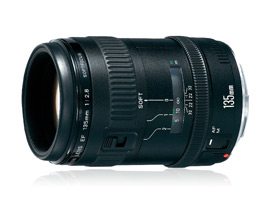Introduction
Wedding, portrait, and landscape photographers can use Canon’s EF 135mm f/2.8 Softfocus lens to create pictures with dream like qualities – the lens allows photographers to add a blur effect, creating heavenly halos around subjects. Relatively affordable and lightweight, the digital version of the 25-year-old EF 135mm f/2.8 Softfocus lens – also capable of snapping razor-sharp images – could be a creative asset in a photographer’s lens kit.

At DxOMark, we put the lens through our rigorous testing. However, we excluded the lens’ two softfocus settings when we analyzed it in our labs. These softfocus settings would have impacted its performance in specific categories like sharpness.

Strengths of the Canon’s EF 135mm f/2.8 Softfocus lens:
• Sharpness was good, especially at f/5.6.
• Chromatic aberration, which was measured at 6µm, was well controlled.
• Distortion was minimal.
Questionable aspects of the Canon’s EF 135mm f/2.8 Softfocus lens:
• The lens received a transmission score of 3.2 T-stop, meaning the widest aperture is closer to f/3.1, not the advertised f/2.8.
• The lens had notable vignetting at the low aperture f/2.8.
The Canon EF 135mm f/2.8 Softfocus lens is the first softfocus lens to be tested at DxOMark. Because it is not possible for DxOMark to compare this unique feature, we contrasted the EF 135mm f/2.8 Softfocus lens against lenses with similar focal-lengths including the Canon EF 135mm f/2L USM and the Canon EF 100mm f/2.8 Macro USM.
Canon EF 135mm f/2.8 Softfocus Lens Advantages:
• Vignetting is most controlled in the 135mm f/2.8 Softfocus lens, at least compared to its Canon relatives.
• With a quick twist of the lens, photographers can utilize the lens’ softfocus feature, which is not available on the 135mm f/2L or 100mm f/2.8 Macro.
• The 135mm f/2.8 Softfocus lens is most affordable of the three lenses. It can be found on photography retail websites for about $500.00 (USD).
Canon EF 135mm f/2L USM Advantages:
• The EF 135mm f/2L USM has the highest sharpness of the group, measuring 14P-Mpix
• It best limits distortion, standing out in the group with a distortion rating of 0.1%.
• The lens has the widest aperture at f/2 and a transmission rating of 2.3 T-stop.
• Tied with the Canon EF 100mm f/2.8 Macro USM for best limiting chromatic aberration.
Canon EF 100mm f/2.8 Macro USM Advantages:
• The lens has good sharpness at 15P-Mpix
• Distortion is well controlled at 0.2%, just behind the EF 135mm f/2L USM
• Performs well at correcting chromatic aberration. Tied with the Canon EF 100mm f/2.8 Macro USM – both registered chromatic aberration scores of 4 µm.
• Its macrophotography capabilities are great for photographers who love to snap detail pictures.
Canon’s EF 135mm f/2.8 Softfocus lens allows users to snap some pretty artistic images – it would make an ideal companion for portrait photographers looking to standout among their peers. But potential buyers should also consider that a number of photography software programs also allow photographers to produce the same foggy and blurry effects that are hallmark of Canon’s Softfocus lens.






DXOMARK encourages its readers to share comments on the articles. To read or post comments, Disqus cookies are required. Change your Cookies Preferences and read more about our Comment Policy.